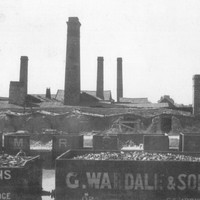E) Riverside

Cambridge Brick & Tile Works
There were kilns with very tall chimneys, used to make bricks and tiles in the 1800s and 1900s. They were located in buildings stretching across a vast area on both sides of the Newmarket Road and all the way over to Coldham’s Lane, now known as Cambridge Retail Park. This means that there used to be chimneys everywhere and smoke-filled air. Abbey became a very industrial area of iron works and timber merchants, brick and tile factories which provided materials for Cambridge buildings in the 19th and 20th centuries. These factories grew in number after 1845 when the railway line was built for Cambridge.

Barnwell Priory
Barnwell Priory was founded in 1092 and is the Abbey for which Abbey ward is named! It hosted numerous medieval kings and even a Parliament. But it was not always popular. It survived a revolt launched by angry locals in 1381, and150 years later it became the target of a more powerful foe, King Henry VIII. Most of the Abbey was dismantled, standing as a ruin from 1538 to 1810. Hardly anything now remains of this medieval landmark, except for the storehouse called the Exchequer (for coins fish and grain), which you can see on Beche Road. The Abbey is now memorialized by the naming of Abbey Meadows School and by the street names which are named after Priors from 800 years ago, as in Thorleye Road, Rayson Way, Stanesfield Road, Gerard Road, Rawlyn Road and Peverel Road.

The Cambridge Museum of Technology
As the population of Cambridge surged with businesses and housing, plus the University growing, there was a problem with sewage and smells in the River Cam. Not only did this cause discomfort to breathing and health problems, it also spread diseases, such as typhoid. The terrible stench and state of the river was noticed alike by poor and rich, worker and monarch. On a visit to Cambridge in 1843, Queen Victoria asked, “What are those pieces of paper floating in the river?” Rather than saying they were book and newspaper pages used as toilet paper, the tactful answer was, “Those Ma’am are notices that bathing is forbidden!”. Eglantyne Jebb was a campaigner for improved living conditions. She wrote an important policy report advocating proper piping from toilets to sewage pipes, and a sewage treatment facility. Her work resulted in the pumping station built on Riverside in 1894 through which the sewage from the city was pumped out to the village of Milton, powered by steam pressure. It was closed down in 1968, but volunteers maintain the steam engines, which are now on display as part of the museum


